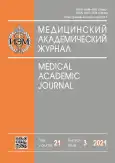Construction of the vaccine strain of the influenza B virus with chimeric hemagglutinin to induce a cross-protective immune response
- Authors: Baranov K.V.1,2, Wong P.1, Stepanova E.A.1, Bazhenova E.A.1, Krutikova E.V.1, Isakova-Sivak I.N.1, Rudenko L.G.1
-
Affiliations:
- Institute of Experimental Medicine
- Peter the Great St. Petersburg Polytechnic University
- Issue: Vol 21, No 3 (2021)
- Pages: 91-96
- Section: Conference proceedings
- URL: https://bakhtiniada.ru/MAJ/article/view/77556
- DOI: https://doi.org/10.17816/MAJ77556
- ID: 77556
Cite item
Abstract
BACKGROUND: Influenza viruses cause worldwide epidemics, and the most effective method to prevent influenza disease is regular vaccinations. The development of new generation vaccines is aimed primarily at the formation of an immune response against a wide range of influenza viruses. One of the promising approaches is sequential vaccination with chimeric influenza viruses with identical stem domains of the hemagglutinin surface protein.
AIM: The development of an experimental vaccine strain of influenza B virus with chimeric hemagglutinin consisting of head and stem domains of influenza B viruses belonging to different genetic lineages.
MATERIALS AND METHODS: A chimeric influenza hemagglutinin gene was obtained by genetic engineering from the genetic material of B/Victoria and B/Yamagata influenza strains. The gene was inserted into the vector for the reverse genetics of the influenza virus. The influenza B virus strain with chimeric hemagglutinin was obtained by transfection of Vero cells using an 8-plasmid system. The rest of the genes were obtained from the attenuated influenza B virus with cold-adapted and temperature-sensitive phenotypes. The biological properties of the obtained recombinant strain, its infectious titer in developing chicken embryos and MDCK cell culture were evaluated.
RESULTS: A recombinant vaccine strain has been successfully rescued. The head domain of the hemagglutinin of the virus is inherited from the B/Victoria influenza virus, and the stem domain from the B/Yamagata virus. The virus actively replicated in eggs and MDCK cells, with temperature-sensitive and cold-adapted phenotypes identical to classical live attenuated influenza vaccine viruses. The thermal stability of the chimeric hemagglutinin did not differ significantly from the thermal stability of the hemagglutinins of the donor viruses.
CONCLUSIONS: The results obtained indicate the possibility of creating a strain with chimeric hemagglutinin, fragments of which are inherited from different genetic lineages. The growth characteristics and biological properties of the strain make it a promising candidate for the experimental evaluation of the possibility of inducing a cross-protective immune response by sequential vaccination with vaccine strains with identical stem hemagglutinin domains.
Full Text
##article.viewOnOriginalSite##About the authors
Konstantin V. Baranov
Institute of Experimental Medicine; Peter the Great St. Petersburg Polytechnic University
Email: mrk2185@gmail.com
ORCID iD: 0000-0002-8476-1469
student
Russian Federation, Saint PetersburgPei-Fong Wong
Institute of Experimental Medicine
Email: po333222@gmail.com
ORCID iD: 0000-0002-7939-6313
Postgraduate student
Russian Federation, Saint PetersburgEkaterina A. Stepanova
Institute of Experimental Medicine
Author for correspondence.
Email: fedorova.iem@gmail.com
ORCID iD: 0000-0002-8670-8645
SPIN-code: 8010-3047
Cand. Sci. (Biol.), Senior Researcher
Russian Federation, Saint PetersburgEkaterina A. Bazhenova
Institute of Experimental Medicine
Email: bazhea@mail.ru
ORCID iD: 0000-0003-3280-556X
Cand. Sci. (Biol.), Senior Researcher
Russian Federation, Saint PetersburgElena V. Krutikova
Institute of Experimental Medicine
Email: krutev@mail.ru
ORCID iD: 0000-0002-0383-2625
SPIN-code: 6330-6128
Cand. Sci. (Biol.), Researcher
Russian Federation, Saint PetersburgIrina N. Isakova-Sivak
Institute of Experimental Medicine
Email: isakova.sivak@iemspb.ru
ORCID iD: 0000-0002-2801-1508
SPIN-code: 3469-3600
Dr. Sci. (Biol.), Head of Laboratory
Russian Federation, Saint PetersburgLarisa G. Rudenko
Institute of Experimental Medicine
Email: vaccine@mail.ru
ORCID iD: 0000-0002-0107-9959
SPIN-code: 4181-1372
Dr. Sci. (Biol.), Professor, Honored Scientist of the Russian Federation
Russian Federation, Saint PetersburgReferences
- Up to 650 000 people die of respiratory diseases linked to seasonal flu each year [Internet]. WHO. Available from: https://www.who.int/news/item/13-12-2017-up-to-650-000-people-die-of-respiratory-diseases-linked-to-seasonal-flu-each-year.Accessed: 17.08.2021.
- Wang Q, Cheng F, Lu M, et al. Crystal structure of unliganded influenza B virus hemagglutinin. J Virol. 2008;82(6):3011–3020. doi: 10.1128/JVI.02477-07
- Chen CJ, Ermler ME, Tan GS, et al. Influenza A viruses expressing intra- or intergroup chimeric hemagglutinins. J Virol. 2016;90(7):3789–3793. doi: 10.1128/JVI.03060-15
- Nachbagauer R, Feser J, Naficy A, et al. A chimeric hemagglutinin-based universal influenza virus vaccine approach induces broad and long-lasting immunity in a randomized, placebo-controlled phase I trial. Nat Med. 2021;27(1):106–114. doi: 10.1038/s41591-020-1118-7
- Ermler ME, Kirkpatrick E, Sun W, et al. Chimeric hemagglutinin constructs induce broad protection against influenza B virus challenge in the mouse model. J Virol. 2017;91(12):e00286–00317. doi: 10.1128/JVI.00286-17
- Reed LJ, Muench H. A simple method of estimating fifty per cent endpoints. American Journal of Epidemiology. 1938;27(3):493–497. doi: 10.1093/oxfordjournals.aje.a118408
- Isakova-Sivak I, Matyushenko V, Kotomina T, et al. Sequential immunization with universal live attenuated influenza vaccine candidates protects ferrets against a high-dose heterologous virus challenge. Vaccines (Basel). 2019;7(3):61. doi: 10.3390/vaccines7030061
Supplementary files







